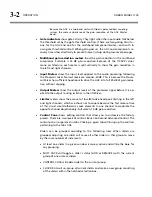
OPTIMOD-PC INSTALLATION
2-41
Threshold) control. In the latter case, you are first likely to notice the problem as
harsh sibilance on voice.
Gain pumping when high frequency energy is present
This will occur with most OPTIMOD-PC factory presets when OPTIMOD-PC’s preem-
phasis is set to 50
µ
s or 75
µ
s. [See step 5 on page 2-24.] The gain pumping happens
because the preemphasis creates a large high frequency boost before the look-
ahead limiter, so the look-ahead limiter must produce large amounts of gain reduc-
tion to control peak levels.
To correct this problem, turn down the
F
INAL
L
IMIT
D
RIVE
control (page 3-39) until the
pumping is no longer audible (see
Processing for Low Bitrate Codecs
on page 3-5). It
may also be helpful to adjust band 5 so that it produces some high frequency limit-
ing. (The
AGC+75
US
LIMITER
factory preset illustrates this technique; see page 3-18.)
Then save your work as a User Preset.
System receiving OPTIMOD-PC’s AES digital output will not lock
Be sure that OPTIMOD-PC’s output sample rate is set to match the sample rate that
the driven system expects. Be sure that OPTIMOD-PC’s digital output format control
is set to match the standard expected by the driven system (either
AES3
or
SPDIF
).
(See step 4 on page 2-22.)
System will not pass line-up tones at full output level/100% modulation
This is normal in
O
PERATE
mode. Sine waves have a very low peak-to-average ratio
by comparison to program material. The processing thus automatically reduces their
peak level to bring their average level close to that of program material, promoting
a more consistent and well-balanced sound quality.
To pass line-up tones transparently, recall OPTIMOD-PC’s
P
ROTECT
preset. If neces-
sary, adjust its gain and save your edited preset as a User Preset.
These tones should be injected into the transmitter after OPTIMOD-PC, or
OPTIMOD-PC should be temporarily switched to
P
ROTECT
to pass the tones.
Alternatively, you can patch the OPTIMOD-PC digital output into one of its digital
inputs. This leaves you with one analog or one digital input into which you can con-
nect the unprocessed audio. Use the remaining unused input to receive the output
of the tone generator. Use the Direct mixer to mix the tone generator and proc-
essed signal as desired.
This scenario is particularly practical if the final output of the system is a
WAVE stream. Otherwise, the only remaining available output is the ana-
log output. Of course, you can reverse the scenario by using the
OPTIMOD-PC analog output and input for the loop-through connection,
in which case the final mixed output could be the digital output.
General dissatisfaction with subjective sound quality
OPTIMOD-PC is a complex processor that can be adjusted for many different tastes.
For most users, the factory presets, as augmented by the gamut offered by the
L
ESS
-
M
ORE
control for each preset, are sufficient to find a satisfactory “sound.” However,
some users will not be satisfied until they have accessed other Modify Processing
controls and have adjusted the subjective setup controls in detail to their satisfac-
tion. Such users
must
fully understand the material in Section 3 of this manual to
achieve the best results from this exercise.
















































